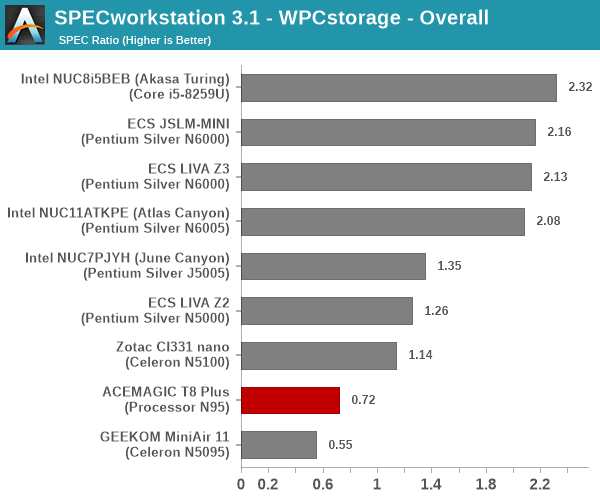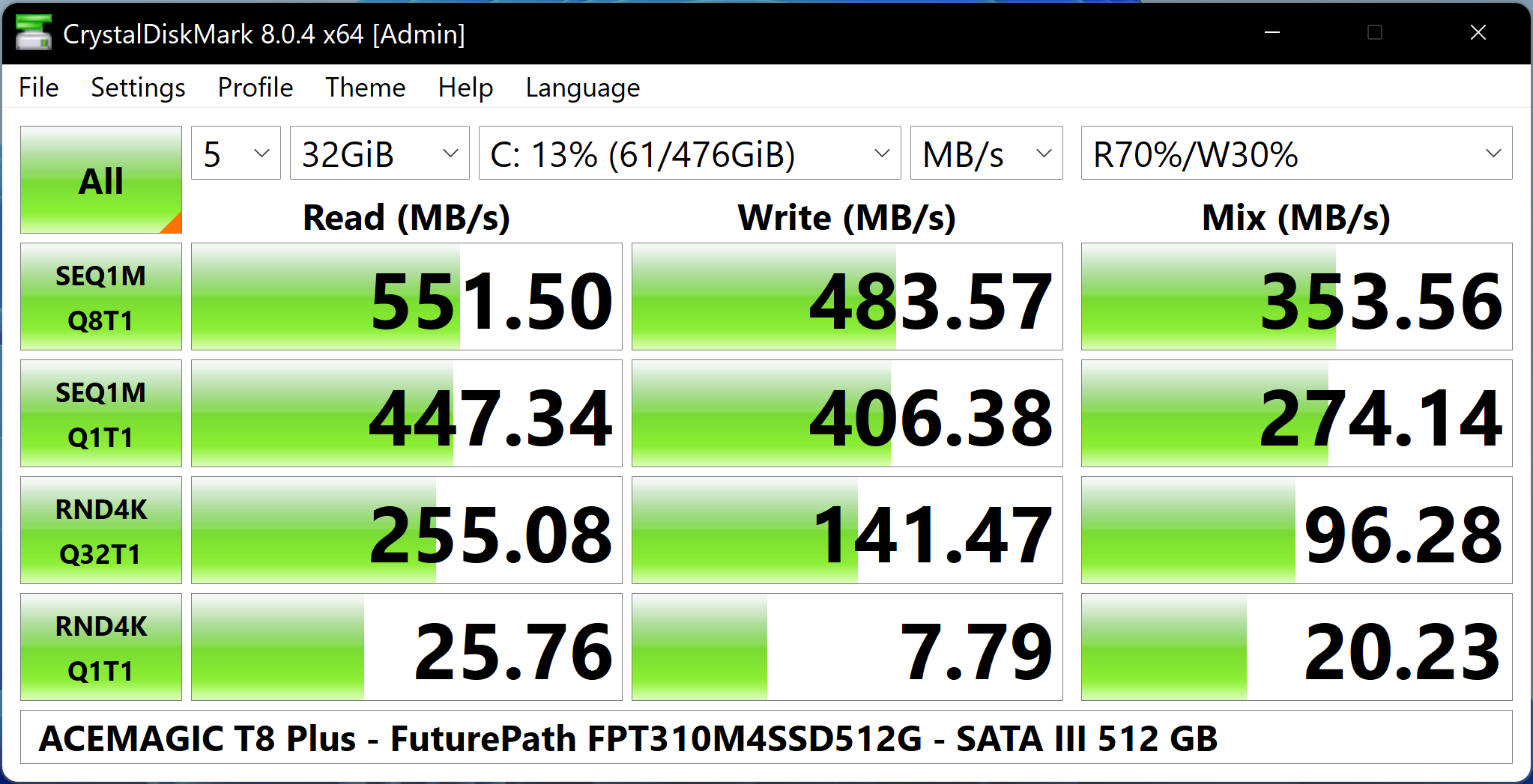ECS LIVA Q3D and ACEMAGIC T8 Plus micro-PCs Review: Jasper Lake and Alder Lake-N in a Smaller-than-UCFF Package
by Ganesh T S on September 21, 2023 9:10 AM EST- Posted in
- Systems
- Intel
- ECS
- LIVA
- Jasper Lake
- Alder Lake-N
- AceMagician
- micro-PC
Miscellaneous Aspects and Concluding Remarks
Networking and storage are aspects that may be of vital importance in specific PC use-cases. The ACEMAGIC T8 Plus comes with dual LAN ports backed by Realtek Gigabit Ethernet network controllers, while the ECS LIVA Q3D has only one wired LAN port. The Wi-Fi support in both systems is a bit dated - Wi-Fi 5. While the ECS system employs a 2x2 solution, the T8 Plus wireless networking support seems to have been an afterthought with a 1x1 solution.
On the storage side, the ECS LIVA Q3D employs an eMMC solution. Unlike the LIVA Z3 that had a M.2 NVMe SSD slot, this system only offers a microSDXC expansion slot. We opted to evaluate the system with the supplied 128 GB eMMC drive. The capacity is too low to run our usual SPECworkstation 3.1 WPCstorage suite, but that was not a problem for the 512GB M.2 SATA SSD in the ACEMAGIC T8 Plus.
From a benchmarking perspective, we provide results from the WPCstorage test of SPECworkstation 3.1. This benchmark replays access traces from various programs used in different verticals and compares the score against the one obtained with a 2017 SanDisk 512GB SATA SSD in the SPECworkstation 3.1 reference system.
| SPECworkstation 3.1.0 - WPCstorage SPEC Ratio Scores | |||

The graphs above present results for different verticals, as grouped by SPECworkstation 3.1. The storage workload consists of 60 subtests. Access traces from CFD solvers and programs such as Catia, Creo, and Soidworks come under 'Product Development'. Storage access traces from the NAMD and LAMMPS molecular dynamics simulator are under the 'Life Sciences' category. 'General Operations' includes access traces from 7-Zip and Mozilla programs. The 'Energy' category replays traces from the energy-02 SPECviewperf workload. The 'Media and Entertainment' vertical includes Handbrake, Maya, and 3dsmax. Given that the comparison is between a wide range of SSDs in the systems - including both Gen 3 NVMe and SATA, the relative numbers for most workloads are not surprising. The FuturePath SATA SSD used in the T8 Plus puts the system consistently in the bottom half of the above graphs.
In order to put the performance of the T8 Plus's storage solution in perspective, we also got the Kingston eMMC drive into the picture with the help of our usual CrystalDiskMark multi-corner workload. With a 32GB span, this workload also exposes possible use of QLC.
| CrystalDiskMark Workloads | |||

Based on the results above, it appears that the FuturePath SSD utilizes TLC NAND. Also, the performance is quite good for a SATA SSD. On the other hand, we see the absence of NCQ support in the eMMC drive. That has a negative impact on the responsiveness and user experience for generic usage. Obviously, there are multiple use-cases (such as digital kiosks or point-of-sale terminals) where the storage drive performance profile may not be that much of a concern.
Closing Thoughts
ECS had pitched their Q series for review multiple times in the past, but I had been wary of taking those up. I had my concerns about the effectiveness of the thermal solution in such a small package and tradeoffs related to the I/O capabilities. A few months back, I noticed multiple micro-PC models from Asian vendors such as AceMagician and GMKtec. With my interest piqued, I took up ECS's pitch for the LIVA Q3D when it came across earlier this year.
Having completed its evaluation early on, we were waiting for it to become available in the market before posting the review. Unfortunately, there is still no sign of the system on either Amazon or Newegg. With Jasper Lake about to go out of style, we managed to quickly source an Alder Lake-N system in a similar form factor from AceMagician. The ACEMAGIC T8 Plus and the ECS LIVA Q3D are both micro-PCs (sub-4x4), but the slightly larger footprint of the T8 Plus allows it to be equipped with additional functionality.
The T8 Plus has three native display outputs compared to the two in the LIVA Q3D. The system also has more number of external high-speed interfaces. In particular, the presence of dual LAN ports opens up a variety of use-cases. The Intel Processor N95 in the T8 Plus is configured for a 15W TDP, and that is enough for it to outperform the 10W Pentium Silver N6000 in the LIVA Q3D across pretty much all CPU and GPU workloads in our evaluation suite. Our only complaints against the T8 Plus are related to the HDR capabilities of some of its HDMI ports, and its unnecessarily proactive thermal throttling. Using USB-C PD for power input (and also using that USB-C port for data purposes) is something we would have liked to see in both systems. Another option would be to incorporate support for PoE operation - hopefully these are aspects that manufacturers can address in the next-generation systems.
Due to the difference in the power budget (15W for the ADL-N Processor N95 and 10W for the Jasper Lake Pentium Silver N6000), we were unable to judge the effectiveness of the improvements made in Gracemont over Tremont from a performance perspective. The additional execution units of the Jasper Lake GPU in the LIVA Q3D over the one in the ADL-N GPU in the T8 Plus also complicated the comparison of the graphical prowess of the two product families. We may have to evaluate other processors in the Alder Lake-N family to get a better idea of the generational improvements.
The micro-PC form factor has its advantages in terms of portability. It can also be deployed in space constrained scenarios where the traditional 4x4 systems are too bulky. However, for this to be a key advantage, such systems must either allow for PoE operation or have DC Euroblock connectors. As they stand now, the LIVA Q3D and T8 Plus are both novelty systems, and most users would be better off with a 4x4 system having more I/O interfaces.

Micro-PCs size comparison against a 4x4 mainstream Intel NUC
ECS indicated that they would be selling the LIVA Q3D N6000 / 4GB RAM / 128GB eMMC model for $285. We believe that the street price should be much lower than that, particularly when systems like the ACEMAGIC T8 Plus are taken into consideration. Our review configuration of the T8 Plus with the Intel Processor N95, 16 GB of LPDDR5-3200 RAM, and a 512 GB M.2 SATA drive is priced at $207. Amazon currently has discount coupons available at checkout, and AceMagician has also provided AnandTech readers with a limited use / limited time coupon UQSYLW9R to bring down the price to $177. At that price, the value proposition of the system is excellent.











8 Comments
View All Comments
ballsystemlord - Thursday, September 21, 2023 - link
@Ganesh , Your pricing info makes it appear as though the coupon itself saves us $177. Please consider removing the "-" (minus) sign, use a comma or a semicolon instead.Samus - Thursday, September 21, 2023 - link
I'm just waiting for someone to chime in about how the Apple M2 is so much faster... XDballsystemlord - Friday, September 22, 2023 - link
Well, we can't disappoint you so...meacupla - Friday, September 22, 2023 - link
I too have never seen that SSD controller/nand maker.HGO? HSO?
That logo looks too similar to HOS from Patlabor
mode_13h - Monday, October 2, 2023 - link
Except that Labors, like Chobits, clearly had hard disks.sjkpublic@gmail.com - Friday, September 22, 2023 - link
Missing a proper NVME connection / controller? Looks like fastest disk speed is 600 MB/s.t.s - Sunday, September 24, 2023 - link
Thanks for the review.From the idle power side, it's quite high, cause my HP elitedesk 800 G4 65 watt can go as low as < 4W with i5-8500T. Asrock Deskmini x300 with ryzen 5700G is about ~12w idle. All measured from the wall.
mode_13h - Monday, October 2, 2023 - link
Let me know when there's a reasonably-priced (i.e. not industrial) Alder Lake-N mini-ITX board with DDR5 support. So far, I've yet to find one.